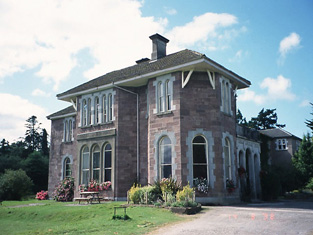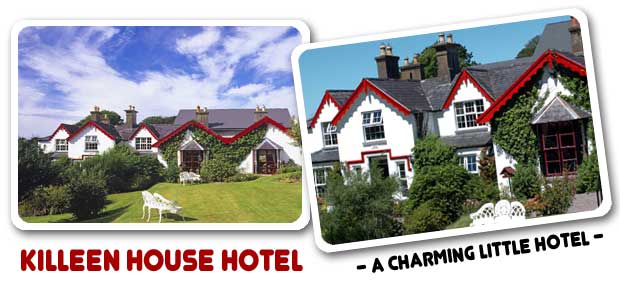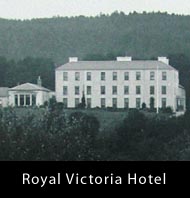Killeen House
Houses within 5km of this house
Displaying 18 houses.
Houses within 5km of Killeen House
Displaying 18 houses.
| House name | Description | |
|---|---|---|
| Summerhill (Mount Meredith) | In 1786 Wilson refers to Mount Meredith as a gentleman's seat close to Killarney. Bary writes that this is the property that later became known as Summerhill, held by The O’Donoghue. The Ordnance Survey Name Books note that this townland was leased by St. John Mason to Richard McGillycuddy and Madam O'Donoghue in the 1830s. The house is described as "formerly a handsome house but is now suffering to go to ruin". At the time of Griffith’s Valuation it was valued at £3 and leased to James Donovan. A substantial modern farm exists at the site now. | |
| Cleeny | At the time of Griffith’s Valuation, Maurice Brennan was leasing a property at Cleeny, valued at almost £7, from The O’Donoghue estate. In 1906 it was owned by Lord Kenmare's estate and valued at £5 15s. Modern farm buildings are located at the site. | |
| Coolgarriv House | James Donovan, MD, was leasing Coolgarriv House from The McGillycuddy’s estate at the time of Griffith’s Valuation, when it was valued at £12 10s. Bary, quoting the Ordnance Survey Name Books, states that Coolgarriv House was built by the Eager family in the 1830s at a cost of £900. It is still extant and occupied. | |
| Curragh House | Lady Headley’s estate was leasing a property valued at £6 5s to James Beazly at the time of Griffith’s Valuation. Bary states that the Beazlys acted as agents for the Headley estate and that Curragh House was built c.1810. The house underwent renovation in the later twentieth century. | |
| Aghadoe House | Lady Headley was in possession of Aghadoe House at the time of Griffith’s Valuation when it was valued at £53. It is mentioned as " a very fine building, densely shaded with trees" in the Ordnance Survey Name Books of the 1830s. Bary, quoting the Name Books, states that it was built in 1828 at a cost of £12,000 though the National Inventory of Architectural Heritage states that it was probably redesigned in the 1860s. It was the seat of Lord Headley in 1894. The house was burnt in 1922 but re-built to the same plan. The Irish Tourist Association survey noted in 1943 that it was then the property of Robin Hilliard and was being extensively renovated. It is now the Killarney International Youth Hostel. |

|
| Aghadoe Cottage | Archdeacon Forester was leasing Aghadoe Cottage from the Headley estate at the time of Griffith’s Valuation when it was valued at £7 10s. Bary states that it was built by the Archdeacon in 1838 though the Ordnance Survey Name Books mention him as being in residence there before that. It is still extant and is now run as Killeen House Hotel. See www.killeenhousehotel.com |

|
| Gortroe Lodge | At the time of Griffith’s Valuation, Gortroe Lodge was being leased by John Morrogh Bernard from John C.O’Riordan when it was valued at £22. Lewis records Gortroe Lodge as the seat of S. Riordan. Bary states that, according to John O’Donovan, Stephen Riordan built Gortroe Lodge in 1831. The house is now demolished and much development has taken place in the area. | |
| Caherdean House | Charles Daly was leasing Caherdean House from Henry Herbert at the time of Griffith’s Valuation, when it was valued at £11 10s. Bary suggests that the Lawlors may have had connections with Caherdean House around 1800 but later in the 19th century the Herberts were the landlords. The house is still extant and part of a large farm. . |

|
| Royal Victoria Hotel | Christopher Gallway was leasing this property to Thomas Finn at the time of Griffith’s Valuation, when it was valued at £65. This appears to be the Royal Victoria Hotel. In the early 1940s the Irish Tourist Association Survey noted that the Victoria Hotel "once the finest hotel in the district" had been converted into a farmhouse "about 130 years" and that there was an expectation that it was to be converted into a golf clubhouse. The site is now occupied by the Castlerosse Hotel, opened in 1960. |

|
| Killarney Mills | Christopher Gallway was leasing an extensive milling concern from the Kenmare estate at the time of Griffith’s Valuation. It was then valued at £85. Lewis refers to "the extensive flour-mills of Messers Galway and Leahy, worked by the river Dinagh" in 1837. Lyons notes that the mill complex was sold in the Encumbered Estates Court in 1855 and purchased by Richard Leahy for £1500. It was taken over by the Electricity Supply Board in 1940. The mills are no longer extant. |

|
| Ballydowny | Bary states that "Ballydowney is a very old house, probably built in the early 18th century. It was the house in which Robert Emmet, the patriot hanged in Dublin in 1803, was born. His mother was Elizabeth Mason". The Ordnance Survey Name Books record that the proprietor, St. John Mason, had leased the townland to Richard McGillycuddy in the 1830s. By the time of Griffith’s Valuation, the house was valued at £4 and being leased by Charles Daly from Daniel Cronin. In the early 1940s, the Irish Tourist Association Survey also refers to the possible association with Robert Emmet though it indicates that this story may refer to an earlier house, "replaced by the present one, built about a hundred years ago". In 1942 it was occupied by a Mr. Blanchfield and is still extant. | |
| Dooneen Cottage (Upper Park Cottage) | This property on the Earl of Kenmare’s estate was valued at £7 10s at the time of Griffith’s Valuation. In 1786 Wilson refers to Dooneen as the seat of Rev. Dr. Bland. Bary states that it had been built in the 18th century and was one of the chief farm properties on the estate. It is labelled Upper Park Cottage on the 25-inch Ordnance Survey map of the 1890s. Part of the original building appears to be still extant. In the same townland is Wood Park Cottage [V985934], also a farm on the Earl of Kenmare’s estate. It is still extant. | |
| Dromadeesirt Cottage | Catherine Thompson was leasing a property valued at £5 from the Earl of Kenmare’s estate at the time of Griffith’s valuation. Bary states that this family may have been agents for Lord Kenmare and that local tradition suggests Mr. Thompson was killed by being gored by his bull. The property was occupied until the late twentieth century and farm buildings are still extant at the site. | |
| Killarney House | The 4th Earl of Kenmare had a new house built in the townland of Knockreer in the 1870s which became known as Killarney House. Bary states that this house was accidentally burnt down in 1913 and never rebuilt. The stable block was later converted into a dwelling and still survives. The last owners, the McShain family, left the property to the nation in the 1960s. An earlier house in this townland, built in 1828,, named in the Ordnance Survey Name Books as Prospect House, was occupied by Thomas Brown in the 1830s. |

|
| Mount Prospect | Walter Murphy, MD, is noted as the lessor of a property at Ballynamaunagh, Kilcummin at the time of Griffith’s Valuation when it was valued at £16. The townland was part of Lord Kenmare’s estate. Bary states that the house may have built by the Murphy family in the late 18th century. No trace exists of it in the area now. | |
| Nunstown | Robert Leeson was leasing a property valued at £5 to Michael Barrett at the time of Griffith’s Valuation. A substantial farm still exists at the site. | |
| Ballyhar House | In 1786 Wilson refers to Ballyhar, the residence of Mr. Eager. John Leahy was in possession of this property at the time of Griffith's Valuation when it was valued at £17. Bary states that this house was originally built by the Eager family but later sold to the Leahys. It is now a ruin. | |
| Prospect (Killarney) | In 1786 Wilson that a house named Prospect, one mile from Killarney, was the seat of Mr. Supple. The Ordnance Survey Name Books mention Prospect House as the residence of Thomas Browne in the 1830s. It seems to have become ruinous after this as only a gate lodge is mentioned in Griffith's Valuation and Prospect is now shown on the 25-inch Ordnance Survey map of the 1890s. |

